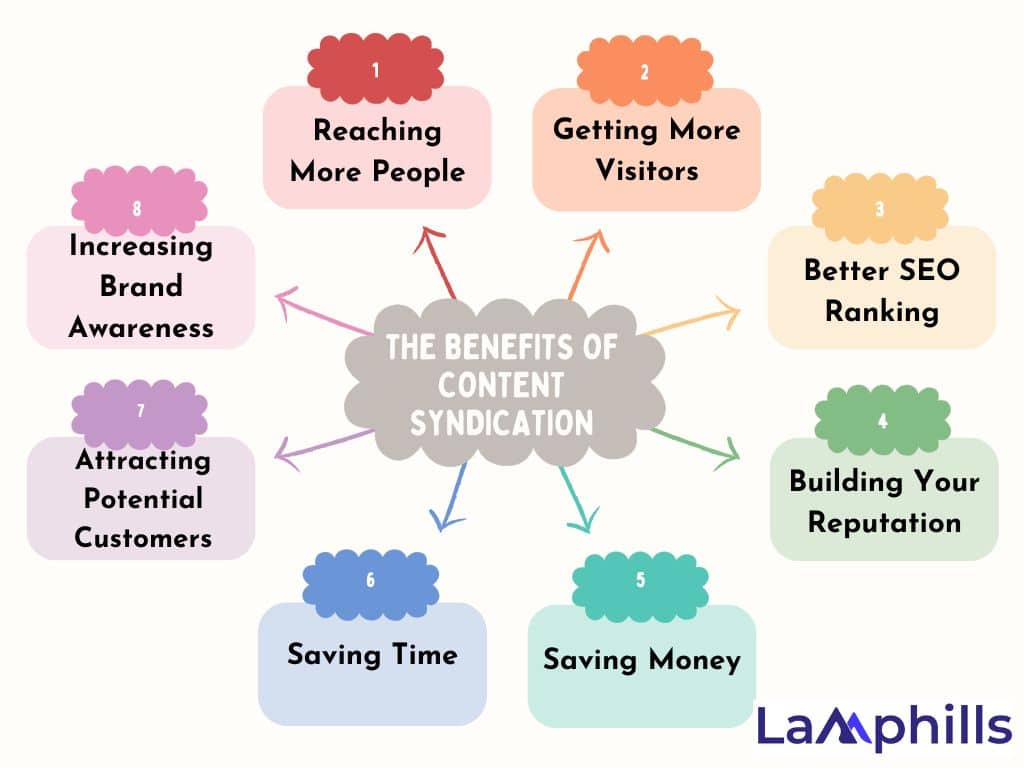Content syndication is a good way to grow your audience and get new customers for your business. This means republishing your original content on other websites. Doing this helps you reach more people and get more backlinks.
Creating great content isn’t enough. You need to make sure it reaches a large audience who will be interested in your brand and products/services. One of the best ways to do this is through content syndication. This strategy involves republishing your content on other sites and networks to gain more exposure and leads for your business.
I still remember the first time I heard about content syndication. It was a few years ago, and I needed help to get one of my client’s blogs noticed. No matter how hard I tried, the traffic just wasn’t growing. One evening, while browsing marketing forums, I read about content syndication. Curious, I decided to try it. That decision changed my content marketing journey.
Before I explain how to syndicate your content, let’s quickly discuss what content syndication is and why it matters.
Key Points
- Content syndication means republishing your original content on other websites. It’s like giving your content a second chance to reach new people without having to create something new.
- Syndicating high-quality articles, infographics, videos, and podcasts can make your products and services more visible, attract high-quality leads, increase website traffic, build credibility and trust, and improve your SEO results. Start by setting your goals, choosing the right types of content, finding the right syndication networks, and tracking how well your syndicated content performs. For more details on content syndication, check out this blog.
- In marketing, content syndication comes in three main types: free, paid, and owned. Understanding these types can help you choose the best way to reach your audience and enhance your brand’s visibility.
- Content syndication is a great way to get your content seen by more people. By sharing your articles, blogs, or videos on different websites, you can reach a larger audience, get more visitors, and build your brand’s reputation.
What Is Content Syndication?
Content syndication means republishing your original content on other websites. It’s like giving your content a second chance to reach new people without having to create something new. When I started, I didn’t know that my articles could appear on well-known sites and reach a larger audience. Using content syndication, I can achieve this and also keep my audience interested with relevant content.
Syndicating high-quality articles, infographics, videos, and podcasts can make your products and services more visible, attract high-quality leads, increase website traffic, build credibility and trust, and improve your SEO results. Start by setting your goals, choosing the right types of content, finding the right syndication networks, and tracking how well your syndicated content performs. For more details on content syndication, check out this blog.
In marketing, content syndication comes in three main types: free, paid, and owned. Understanding these types can help you choose the best way to reach your audience and enhance your brand’s visibility. Let’s see a brief explanation of each type.
Read Also: Content Syndication: A Comprehensive Guide
Types of Content Syndication in Marketing
Content syndication can be grouped into three types: free, paid, and owned. Here’s a simple explanation of how each type works:
#1. Free Syndication
Free syndication means sharing your content on different platforms without paying any money. Other websites and blogs can republish your articles for free, as long as they give you credit. This helps more people see your content and builds your reputation.
#2. Paid Syndication
Paid syndication involves paying websites or social media platforms to feature your content. Your articles might appear in special spots, like a homepage or as a promoted post, which helps more people see and click on them. This method targets users who are likely to be interested in your content.
#3. Owned Syndication
Owned syndication is when you share your content on platforms you control, such as your website, social media pages, and email newsletters. You decide where and how to share your content, ensuring it reaches your audience. For example, you might post a blog on your website, share it on LinkedIn, and include it in your newsletter. This helps you engage with everyone interested in your brand.
In summary, free syndication spreads your content without any cost, paid syndication ensures strategic placements and owned syndication gives you full control. By using a mix of these types, you can effectively share your content and strengthen your brand’s presence across different platforms.
Now, let’s see why you should syndicate your content.
The Benefits of Content Syndication
Ever since I learned about content syndication, I’ve benefited a lot from it. Content syndication is a great way to get your content seen by more people. By sharing your articles, blogs, or videos on different websites, you can reach a larger audience, get more visitors to your site, and build your brand’s reputation. I’ve used content syndication a lot and can tell you it works. Here’s why and how:

#1. Reaching More People
One of the biggest benefits is reaching more people. When you share your content on other websites, their readers get to see it. This means people who might never visit your website can still read your content. For example, I once shared an article on a popular website in my industry and saw a big increase in visitors to my site. These new readers were interested in what I had to say.
#2. Getting More Visitors
Content syndication doesn’t just help you reach more people; it also brings more visitors to your website. When people see your content on other sites, they often click through to your site to learn more. I remember when I shared a series of blog posts; the number of visitors to my site went up by 30%. This not only improved my site stats but also brought in new potential customers.
#3. Better SEO Ranking
Content syndication is also good for search engine optimization (SEO). When your content is on several respected sites with links back to your website, search engines see your site as more important. This can help your site rank higher in search results. After I started syndicating my content, my website’s ranking improved, leading to more people finding my site through search engines.
#4. Building Your Reputation
Being featured on well-known websites helps build your reputation as an expert in your field. This can be very valuable, especially in competitive industries. When I first started sharing my content on other sites, I quickly gained a reputation as an expert. This not only increased my followers but also led to opportunities for speaking at events and collaborating with others.
#5. Saving Money
Content syndication is a cost-effective way to market your business. Unlike paid advertising, which can be expensive, syndicating your content usually costs little or nothing. This makes it a good option for businesses with small marketing budgets. I’ve found that the return on investment (ROI) from content syndication is much higher than many other marketing methods I’ve tried.
#6. Saving Time
Creating new content for every platform can take a lot of time. Content syndication lets you use the same piece of content on multiple sites. This saves time and makes sure your message is consistent everywhere. In my experience, syndicating content has given me more time to focus on other important parts of my business.
#7. Attracting Potential Customers
One of the main goals of content marketing is to attract potential customers, and content syndication is great for this. When your content reaches a wider audience, it can attract more people who might be interested in your products or services. I once shared a whitepaper through syndication, and the number of leads I got from that single piece of content was amazing. These leads were more likely to become paying customers.
#8. Increasing Brand Awareness
As more people see your content on different platforms, your brand becomes more well-known. This increased awareness can lead to higher trust and loyalty from your audience. I’ve seen this happen with my brand; as my content appeared on more sites, more people became familiar with my business, leading to a stronger presence in the market.
Content syndication offers many benefits, from reaching more people and boosting website traffic to improving SEO and building your reputation. This strategy is cheaper, saves time, and can attract potential customers while increasing brand awareness. By using content syndication, you can greatly improve your online presence and grow your business.
Who Should Use Content Syndication?
If you’re wondering whether content syndication is right for you, here’s who should consider it to reach and engage their audiences:
- Small businesses
- Bloggers and Influencers
- Startups
- Marketing Agencies
- Non-Profit Organizations
- Marketing Agencies
- E-Commerce Businesses
- Anyone wanting to build a personal brand
This is because content syndication can be beneficial for various individuals and organizations. Here’s a quick explanation:
#1. Small Businesses
Small businesses can use content syndication to attract more customers. By sharing informative articles, videos, or other content on popular sites, they can increase their visibility and build trust with potential clients.
#2. Bloggers and Influencers
If you write a blog or create content online, content syndication can help you reach a larger audience. By sharing your content on other websites, more people can see your work, which can lead to more followers and engagement.
#3. Startups
New companies looking to make a name for themselves can benefit greatly. Syndicating their content can quickly spread the word about their products or services, helping them grow faster.
#4. Marketing Agencies
Agencies that create content for various clients can use syndication to boost their clients’ online presence. This can lead to better results for their marketing campaigns.
#5. Nonprofit Organizations
These organizations can use content syndication to raise awareness about their causes. By sharing their stories and missions on larger platforms, they can attract more donors and volunteers.
#6. E-commerce Businesses
Online stores can syndicate content like product reviews, how-to guides, and industry news. This can drive traffic to their website and boost sales.
#7. Publishers and Media Companies
They can syndicate content to keep their audience engaged with fresh material. This can also help them reach new readers who visit other sites.
#8. Educational Institutions
Schools, colleges, and universities can share their research, news, and educational materials through syndication. This can enhance their reputation and attract more students and faculty.
Overall, anyone who creates valuable content and wants to reach a broader audience should consider content syndication. It’s an effective way to enhance visibility, build credibility, and grow an online presence.
How to Use Content Syndication
If you want more people to see your content, then content syndication can help! Let me show you how to use content syndication to make your content reach more people and have a bigger impact with these simple steps:
#1. Define Your Goals
Many marketers use content marketing to achieve goals like increasing brand awareness, building credibility, and generating leads. To make the most of content syndication, it’s important to understand your goals clearly.
To understand the reason why you want to use content syndication, you can ask yourself these questions:
- Will sharing this content help you meet your business goals?
- Will it drive users to pages designed to convert them into customers?
- Will it help your content get noticed on syndication sites and networks?
#2. Find the Right Platforms
The next step is finding platforms and partners for syndication that match your niche and audience. Look for reputable websites, blogs, and networks related to your content. When I began, I made a list of potential sites by researching where my competitors’ content was being syndicated.
#3. Create Quality Content
Not all content is suitable for syndication. Focus on creating high-quality, evergreen content that readers find valuable. My detailed guides and how-to articles were particularly successful in attracting syndication opportunities.
Adjust your content to fit the standards and preferences of your syndication partners. This might include changing the format or style to match the platform’s requirements.
#4. Pitch Your Content
Contact the editors of your target websites with a compelling tone. Personalize your email and explain why your content would be valuable to their audience. I found that providing a summary and the key benefits of my article increased my chances of getting a positive response.
#5. Negotiate Terms
Make sure the syndication terms include a link back to your original article. This is crucial for getting the SEO benefits and ensures your content remains consistent with your brand’s identity. In my experience, most websites were willing to include a backlink, giving credit to the original source.
#6. Foster Relationships
Build and maintain good relationships with your syndication partners. Keep communication open, show appreciation, and be open to feedback. Consider ways to reciprocate, like co-authoring articles or sharing each other’s content. This helps create a long-term, mutually beneficial partnership.
#7. Use Syndication Networks
Consider using content syndication networks like Outbrain, Taboola, or Zemanta. These platforms can help automate the process and expand your reach even further. I initially used Outbrain to syndicate my content, and it was very effective.
By following these steps, you can post your work on many platforms, bring more visitors to your site, and improve your online presence.
Below is a checklist on how you can content syndication effectively
Like any content-sharing strategy, content syndication has its challenges, let’s take a look at some.
The Challenges of Content Syndication
Content syndication, or sharing your content on other websites to reach more people, can be a great strategy. However, it comes with its own set of challenges. Based on my experience in content marketing, here’s a list of the major challenges you might face and how you can overcome them:
#1. Duplicate Content Problems
One big worry with content syndication is duplicate content, which can hurt your search engine rankings. Google prefers original content, and if your syndicated content isn’t handled correctly, your SEO efforts might suffer. I remember a project where we shared our blog posts on a popular industry site without using the right tags. Our site’s rankings dropped temporarily until we fixed the issue with the third-party site.
Solution: Always make sure that syndicated content includes a link back to the original post. This tells search engines which version is the main source, protecting your SEO.
#2. Maintaining Content Quality
When you share your content on other platforms, you don’t control how it’s presented, which can sometimes lead to changes that don’t match your quality standards. I once had an article shared by a reputable site, only to find out they made significant edits that changed the tone and accuracy of the piece.
Solution: Set clear guidelines and expectations with the syndication partner. Review and approve any changes before the content goes live to ensure it meets your quality standards.
#3. Audience Overlap
While syndication aims to expand your reach, there’s a risk of overlapping audiences, leading to repeated exposure. This can reduce the impact of your content and cause audience fatigue. In my early days, I noticed our content being shared on several sites with the same audience, which led to fewer engagements.
Solution: Research the audience demographics of potential syndication partners. Choose platforms that reach different segments of your target market to maximize your reach without too much overlap.
#4. Brand Consistency
When your content appears on various third-party sites, keeping a consistent brand voice and message can be challenging. I’ve had instances where syndication partners added their own branding, which confused our audience about the original source of the content.
Solution: Create a syndication kit that includes guidelines on how your content should be presented, including branding elements, logos, and author bios. Regularly check syndicated content to ensure it follows your brand standards.
#5. Measuring Impact
Tracking how well your syndicated content performs can be difficult because you often have limited access to the third-party site’s analytics. This makes it hard to measure ROI and understand how syndicated content helps your overall marketing goals. I faced this challenge with a media partner who provided minimal insights into how our syndicated articles performed.
Solution: Negotiate access to performance metrics as part of your syndication agreement. Use UTM parameters in links to track traffic and conversions from syndicated content in your analytics platform.
Handling these challenges requires careful planning and strategy. By addressing these issues proactively, you can use content syndication to expand your reach and influence while maintaining the quality and impact of your content.
Advanced Tips for Maximizing Content Syndication
Now you’ve mastered the basics, here are some tips to help you get even better results from content syndication:
#1. Choose the Right Platforms:
Not all platforms are the same. Pick websites that have a good reputation and attract the kind of audience you want to reach. This way, you’re more likely to get valuable traffic.
#2. Repurpose Content:
Turn your best-performing articles into different formats, like infographics, videos, or podcasts, before syndicating them. I turned a popular blog post into a video tutorial and shared it on video platforms, bringing in a new wave of audience members.
#3. Monitor Performance:
Keep track of how your syndicated content is performing. Use analytics tools to measure traffic, engagement, and SEO impact. This data helped me improve my syndication strategy over time.
#4. Engage with the New Audience:
Don’t just sit back once your content is syndicated. Engage with the readers on the third-party sites by responding to comments and questions. This helped me build relationships with a wider audience.
#5. Use Snippets and Teasers:
Instead of sharing the entire content, provide a snippet or teaser with a link back to your original article. This drives traffic back to your site and keeps your SEO strong.
#6. Use Templates:
Using templates for your syndication pitches can make the process easier and more consistent. I developed a pitch template that highlighted the key points clearly, making it easier to reach out to multiple websites efficiently.
#7. Regularly Update Your Content:
Fresh content performs better. Regularly update your syndicated content to keep it relevant and interesting for new readers.
Maximizing content syndication requires a bit more effort, but it’s worth it. By choosing the right platforms, offering exclusive content, using snippets, and keeping your content updated, you can reach a broader audience and make the most out of your content syndication efforts.
Conclusion
Content syndication was a key strategy that changed my content marketing efforts. By understanding what it is, its benefits, and how to use it effectively, you can expand your content’s reach and establish yourself as an authority in your industry.
Answers to Frequently Asked Questions
What is the content syndication process?
Content syndication is a marketing method where you share your content on other websites or platforms to reach more people. It can help you make more people aware of your brand, bring more visitors to your site, and get more leads or sales.
Why is content syndication important?
Content syndication offers many advantages. By sharing your content with a larger audience, you can expand your brand’s reach and visibility. Additionally, syndicating your content can bring more visitors to your website, generate potential customers, and help you become a recognized expert in your field.
Is content syndication good for SEO?
Don’t worry, many marketers struggle with getting enough traffic. There are various ways to increase your numbers, but content syndication is a great option. It’s affordable, increases brand awareness, and enhances your SEO.
What is the difference between content syndication and backlinks?
Content syndication is a way to share your content on different platforms to reach more people. It can also help you get backlinks, which are links from other websites to yours. Backlinks are important for SEO because they show search engines that your content is useful and relevant.
Is content syndication paid media?
Paid content syndication is when you spend money to share your content with your target audience. This method helps your content reach more people and, if done right, can boost your return on investment (ROI) by using the content to generate leads.
Related Articles
Content Syndication: A Comprehensive Guide
Benefits-of-Content-Syndication
Overcoming-Common-Challenges-in-Content-Syndication





